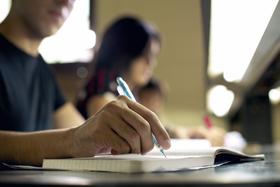Top Rankings
Spartanburg 06 School District ranks among the top 20% of public school district in South Carolina for:
Category
Attribute
Diversity
Most diverse schools (Top 1%)
For the 2025-26 school year, there are 3 public middle schools serving 2,645 students in Spartanburg 06 School District. This district's average middle testing ranking is 5/10, which is in the bottom 50% of public middle schools in South Carolina.
Public Middle Schools in Spartanburg 06 School District have an average math proficiency score of 27% (versus the South Carolina public middle school average of 34%), and reading proficiency score of 38% (versus the 46% statewide average).
Minority enrollment is 63% of the student body (majority Black), which is more than the South Carolina public middle school average of 52% (majority Black).
Overview
This School District
This State (SC)
# Schools
14 Schools
352 Schools
# Students
11,773 Students
221,816 Students
# Teachers
808 Teachers
15,785 Teachers
Student-Teacher Ratio
15:1
15:1
Student By Grade
District Rank
Spartanburg 06 School District, which is ranked within the top 50% of all 74 school districts in South Carolina (based off of combined math and reading proficiency testing data) for the 2022-2023 school year.
The school district's graduation rate of 84% has decreased from 89% over five school years.
Overall District Rank
#33 out of 74 school districts
(Top 50%)
(Top 50%)
Math Test Scores (% Proficient)
39%
43%
Reading/Language Arts Test Scores (% Proficient)
45%
52%
Science Test Scores (% Proficient)
40%
50%
Graduation Rate
84%
84%
Students by Ethnicity:
Diversity Score
0.72
0.66
% American Indian
n/a
n/a
% Asian
3%
2%
% Hispanic
23%
13%
% Black
30%
31%
% White
37%
48%
% Hawaiian
n/a
n/a
% Two or more races
7%
6%
All Ethnic Groups
District Revenue and Spending
The revenue/student of $14,002 in this school district is less than the state median of $15,223. The school district revenue/student has stayed relatively flat over four school years.
The school district's spending/student of $12,552 is less than the state median of $14,820. The school district spending/student has stayed relatively flat over four school years.
Total Revenue
$165 MM
$12,084 MM
Spending
$148 MM
$11,764 MM
Revenue / Student
$14,002
$15,223
Spending / Student
$12,552
$14,820
Best Spartanburg 06 School District Public Middle Schools (2025-26)
School
(Math and Reading Proficiency)
(Math and Reading Proficiency)
Location
Quick Facts
Rank: #11.
R. P. Dawkins Middle School
(Math: 36% | Reading: 43%)
Rank:
Rank:
4/
Bottom 50%10
1300 East Blackstock Road
Moore, SC 29369
(864) 576-8088
Moore, SC 29369
(864) 576-8088
Gr: 6-8 | 847 students Student-teacher ratio: 14:1 Minority enrollment: 69%
Rank: #22.
L. E. Gable Middle School
(Math: 28% | Reading: 43%)
Rank:
Rank:
4/
Bottom 50%10
198 Ott Shoals Road
Roebuck, SC 29376
(864) 576-3500
Roebuck, SC 29376
(864) 576-3500
Gr: 6-8 | 791 students Student-teacher ratio: 13:1 Minority enrollment: 38%
Rank: #33.
Fairforest Middle School
(Math: 19% | Reading: 29%)
Rank:
Rank:
2/
Bottom 50%10
150 Lincoln School Road
Spartanburg, SC 29301
(864) 576-1270
Spartanburg, SC 29301
(864) 576-1270
Gr: 6-8 | 1,007 student Student-teacher ratio: 13:1 Minority enrollment: 77%
Recent Articles

U.S. Public vs. Private Schools Guide 2025
A clear, up-to-date 2025 guide comparing U.S. public and private schools鈥攖uition, funding, outcomes, policy trends, and expert insights for families and educators.

Best School Match 2025: Public vs Charter vs Magnet Meta Description
A 2025 guide comparing public, charter, and magnet schools to help families choose the best education match.

Private vs. Public School: Reality Check- 2025
A 2025 update on private vs. public schools鈥攖uition, enrollment trends, policy shifts, and what parents should consider in today鈥檚 landscape.





